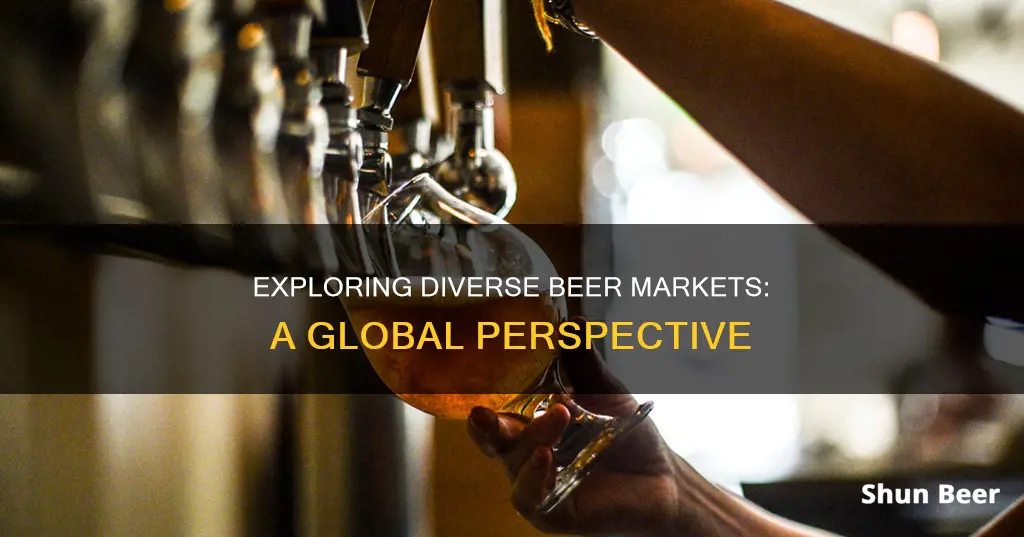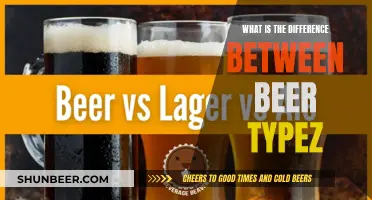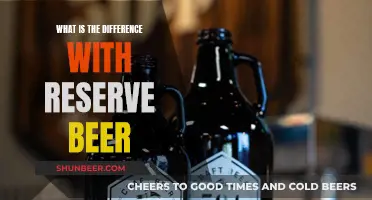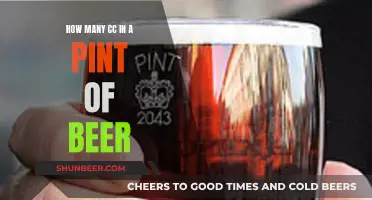
The beer market is a complex and evolving industry, with various segments and target markets. The Brewers Association defines a craft brewer as a small and independent producer, and identifies six distinct market segments within the craft beer industry: microbreweries, brewpubs, taproom breweries, regional breweries, contract brewing companies, and alternating proprietors. The overall beer market can be divided into alcoholic beer (minimum 0.5% ABV) and non-alcoholic beer (maximum 0.5% ABV). Within these broad categories, there are different types of beer, such as lager, ale, stouts, and pilsner, and different packaging types, such as glass bottles and metal cans. The market can also be segmented by distribution channels, with on-trade and off-trade channels offering beer to consumers in different settings. The beer market is influenced by various factors, including consumer preferences, economic conditions, and government regulations, and is expected to continue evolving and growing in the coming years.
| Characteristics | Values |
|---|---|
| Market Size | USD 821.39 billion in 2023 |
| Market Growth | Projected to grow from USD 851.15 billion in 2024 to USD 1,167.47 billion by 2032 |
| Market Segmentation | Type (Lager, Ale, Stouts, and Others), Packaging (Glass Bottle and Metal Can), Distribution Channel (On-trade and Off-trade), Production (Macro brewery and Microbrewery), and Category (Standard and Premium) |
| Market Regions | Europe, Asia Pacific, North America, and South America |
| Key Players | Anheuser-Busch InBev, Heineken, China Resources Snow Breweries, Carlsberg, Diageo, and Molson Coors |
| Market Trends | Rise of craft beer, low-alcohol and non-alcoholic beers, alcohol-based e-commerce channels, disposable income, and socialization among consumers |
What You'll Learn

Craft beer vs. traditional beer
Craft beer and traditional beer are two very different products with distinct production processes, ingredients, and target markets.
Craft beer is often associated with small-scale, independent breweries, known as "microbreweries", that produce beer in limited quantities, focusing on unique flavours and high-quality ingredients. On the other hand, traditional beer, or "macrobreweries", is mass-produced by large-scale breweries, prioritizing efficiency and standardized taste.
Craft beer is typically brewed in small batches, with brewmasters meticulously selecting ingredients to create distinct flavours and aromas. This attention to detail results in craft beers having more intense and diverse flavours, ranging from hints of chocolate and sweet caramel to floral hops and fruity notes. The human factor is essential in craft beer production, as brewers take pride in their craft, experimenting with different ingredients and techniques.
In contrast, traditional beer is produced in large quantities, often using automated processes. While this ensures consistency in taste, it also limits the variety of flavours. Traditional beers usually have a pale yellow colour and are designed to be consumed ice cold in large amounts. They often contain artificial flavourings and additives, and cheaper ingredients, such as rice or corn, to cut costs and appeal to a wider audience.
The difference in production methods also results in variations in alcohol content. Craft beers tend to have higher alcohol percentages, typically ranging from 7% and upwards, while traditional beers usually fall between 3-5% alcohol content.
The target market for craft beer tends to be consumers who appreciate unique flavours, local production, and the story behind the beer. Craft beer enthusiasts are often willing to pay a premium for the higher quality and distinct taste. In contrast, traditional beer targets a broader market, aiming for accessibility and affordability, making it a popular choice for casual drinkers.
In summary, the key differences between craft beer and traditional beer lie in their production methods, ingredients, flavour profiles, alcohol content, and target markets. Craft beer emphasizes creativity, local ingredients, and unique flavours, while traditional beer focuses on standardization, mass production, and accessibility.
Explore the Diverse World of Beer Styles
You may want to see also

Beer sales and recessions
Beer sales have historically been fairly recession-resistant. During economic downturns, consumers tend to opt for cheaper alcoholic beverages, and beer is cheaper than wine and spirits. Beer is also an important feature of socialising for many people, making consumers reluctant to give it up.
However, this does not mean that beer sales are entirely recession-proof. During the Great Recession of 2008, beer and cider sales declined by 1% in 2009, compared to a 6% growth rate in 2007. This was due to a combination of duty rises, an on-premise slump, and increased at-home consumption, which tends to favour spirits and wine.
During recessions, consumers are more likely to drink at home as it is less expensive than buying drinks at bars or restaurants. This trend was also observed during the 2020-2021 recession, where beer sales in stores surged but craft breweries still struggled. This is because craft breweries rely heavily on draft beer sales from bars, restaurants, and other public venues, which were closed during the pandemic.
According to an analysis by Goldman Sachs, beer and spirits volumes in the US have shown little correlation with economic growth. The general trend of per capita consumption of alcoholic beverages seems to have a more significant impact on volumes than the economy. However, during economic downturns, consumers may trade down to more affordable products, and producers may need to raise prices to compensate for increasing production costs.
Pilsner vs Lager Beer: What's the Difference?
You may want to see also

Beer taxation and regulations
Advertising restrictions and labelling requirements can also impact marketing expenses for beer producers, causing them to adjust their pricing strategies. Regulatory hurdles related to distribution and licensing can further affect operational costs. For example, the three-tiered distribution system, established post-Prohibition, requires alcohol to pass through a middleman before reaching consumers. This regulation limits producers' control over the primary phases of the industry, potentially reducing competition and raising prices.
State and federal regulations also apply to brew-on-premises (BOP) businesses, which provide space and equipment for customers to brew and bottle their own beer. While Federal excise tax is typically imposed on beer production, individuals brewing beer at a BOP for personal or family use are exempt from this tax. However, BOP proprietors must comply with state and local laws, and there are restrictions on the type of assistance they can provide to customers.
Changes in taxation policies and regulatory requirements can have a direct impact on the pricing strategies of breweries. For instance, alterations in excise taxes or mandatory labelling requirements can influence the cost structure for breweries, leading them to adjust their pricing accordingly. Additionally, shifts in consumer preferences for specific beer styles or attributes can also drive changes in pricing strategies as breweries adapt to meet demand.
Overall, the complex interplay between taxation, regulations, and consumer dynamics significantly shapes the beer industry's financial landscape and the pricing of beer for consumers.
German Beer Imports: Different or Just Marketing?
You may want to see also

Beer distribution channels
The three-tier system, established post-Prohibition, acts as a safeguard against large producers controlling the market. It provides independent wholesalers, who then sell to independent retailers, protecting them from pressure to only sell certain products. This system also benefits small brewers, as wholesalers can provide distribution equipment, marketing, and sales expertise, making it easier for them to access consumers.
In recent times, the COVID-19 pandemic and the rise of e-commerce have influenced beer distribution. Off-trade sales, including e-commerce and retail stores, rose significantly during the pandemic, while on-trade sales in bars and restaurants were negatively impacted. The Direct-to-Consumer (DTC) channel also expanded, allowing small breweries to thrive.
The distribution channels for beer are varied and evolving, with the three-tier system co-existing alongside the two-tier system and direct-to-consumer sales. These channels play a crucial role in shaping the beer market and ensuring that a diverse range of beer reaches consumers.
Explore the Difference Between Ales and Lagers in Beer
You may want to see also

Beer packaging
Packaging is a crucial aspect of the beer business, accounting for up to two-thirds of the cost of beer production. It is also one of the most critical steps in the brewing process, as a single mistake can ruin an entire batch of beer. Packaging must protect the product during shipping and attract customers at retail and online.
There are several steps to designing beer packaging:
- Determine your packaging needs: What type of packaging is required? Are there any new innovations that can be implemented? How many units are needed? How can the packaging be an extension of your brand?
- Establish your budget: Consider both visible and hidden costs. Visible costs include the upfront cost of design and the price of the packaging itself, while hidden costs can include additional filler and breakage.
- Assess the competition: With over 3,000 breweries in the US producing about 30,000 unique beer styles, it is essential to make sure your packaging stands out.
- Design your packaging: 75% of consumers are influenced by package design. Consider the style of beer, target customer, and purchasing location. Include information about the brewery, beer name, flavour, and ABV. Use eye-catching graphics and a colour palette that fits your label and brand.
- Use new beer packaging and marketing innovations: Consider incorporating QR codes, digitised printing, and eco-friendly packaging.
- Consider a whole set of packaging: A mother carton, for example, is a large container that holds standard 12-ounce bottles and can be enhanced with graphics to match your brewery's branding.
- Choose a printing style: Options include lithography printing, high-speed digital printing, and flexography printing, each with its own advantages and disadvantages in terms of cost, quality, and customisation.
- Create a dieline: Transfer your design to the structure template using a computer designing tool such as Adobe Illustrator or Adobe InDesign.
- Prepare the artwork: Work with your packaging partner to deliver high-resolution artwork for printing.
- Create a prototype: Always request a prototype box to confirm the structure and printing before final production, especially for large orders.
- Production and shipping: Finalise your design and wait for your packaging to arrive. Work with a packaging specialist to map out your inventory expectations and schedule to maintain a healthy inventory flow.
Beer vs Lager: What's the Difference?
You may want to see also
Frequently asked questions
The beer market can be segmented by type, packaging, distribution channel, production, and category. The main types of beer are lager, ale, stouts, and others. Beer is typically packaged in glass bottles or metal cans. It is distributed through on-trade and off-trade channels, with off-trade channels being more popular as they are more cost-effective for consumers. Beer is produced in macro breweries and microbreweries, with macro breweries being the dominant production method. Finally, the beer market can be categorized into standard and premium, with premium beer expected to dominate the market in the future.
The craft beer market is a segment of the overall beer market, and it has been growing in recent years. Craft beer is typically produced by small and independent brewers, with an emphasis on unique and innovative flavors. On the other hand, traditional beer is mass-produced by large brewers and tends to be more standardized.
Economic conditions can significantly impact the beer market. During economic prosperity, consumers have more disposable income to spend on discretionary items like beer, leading to increased sales. On the other hand, during economic downturns, consumers may cut back on non-essential purchases, which can result in a decline in beer demand. Additionally, factors such as changing consumer preferences, income levels, and social trends can also influence the beer market.







